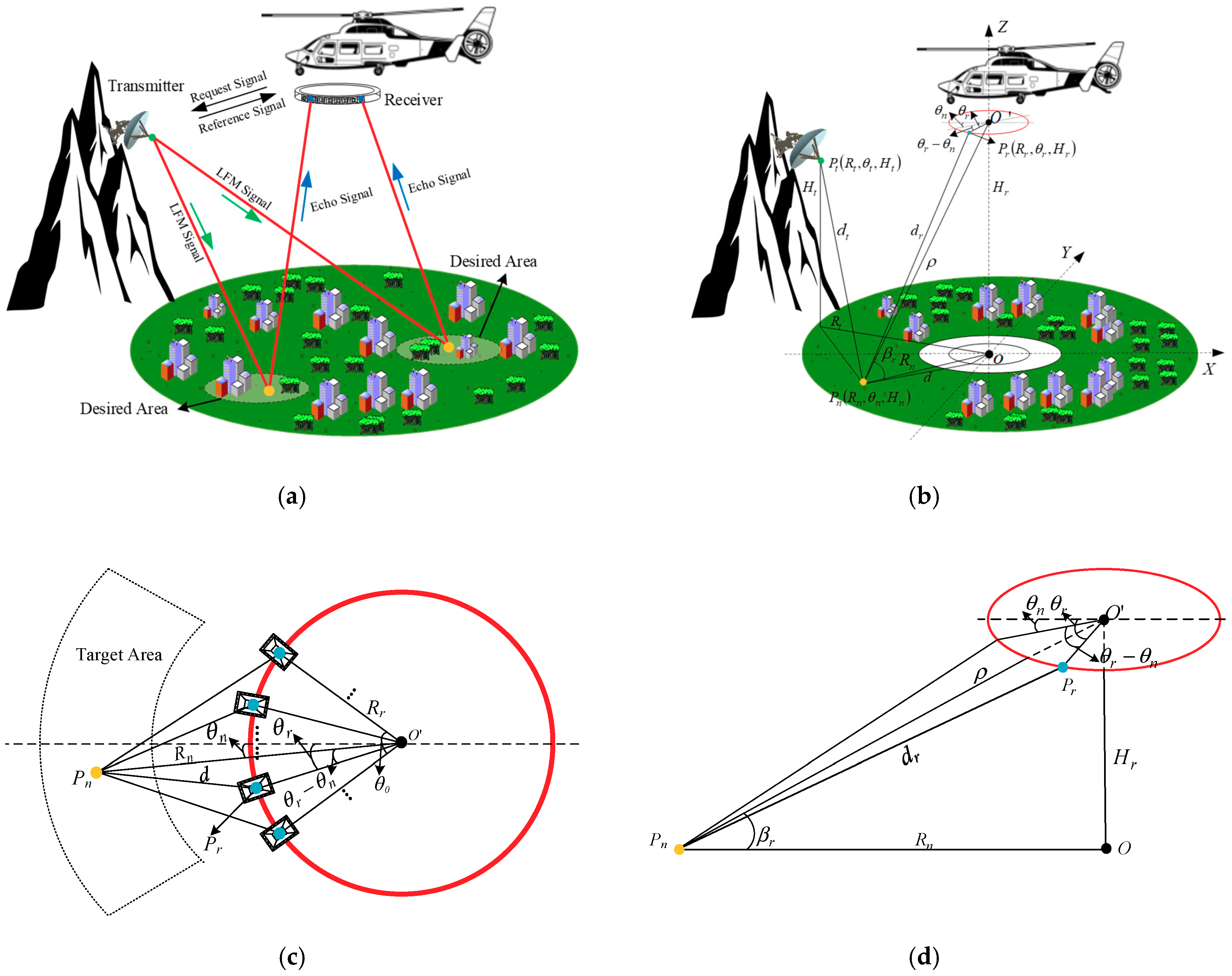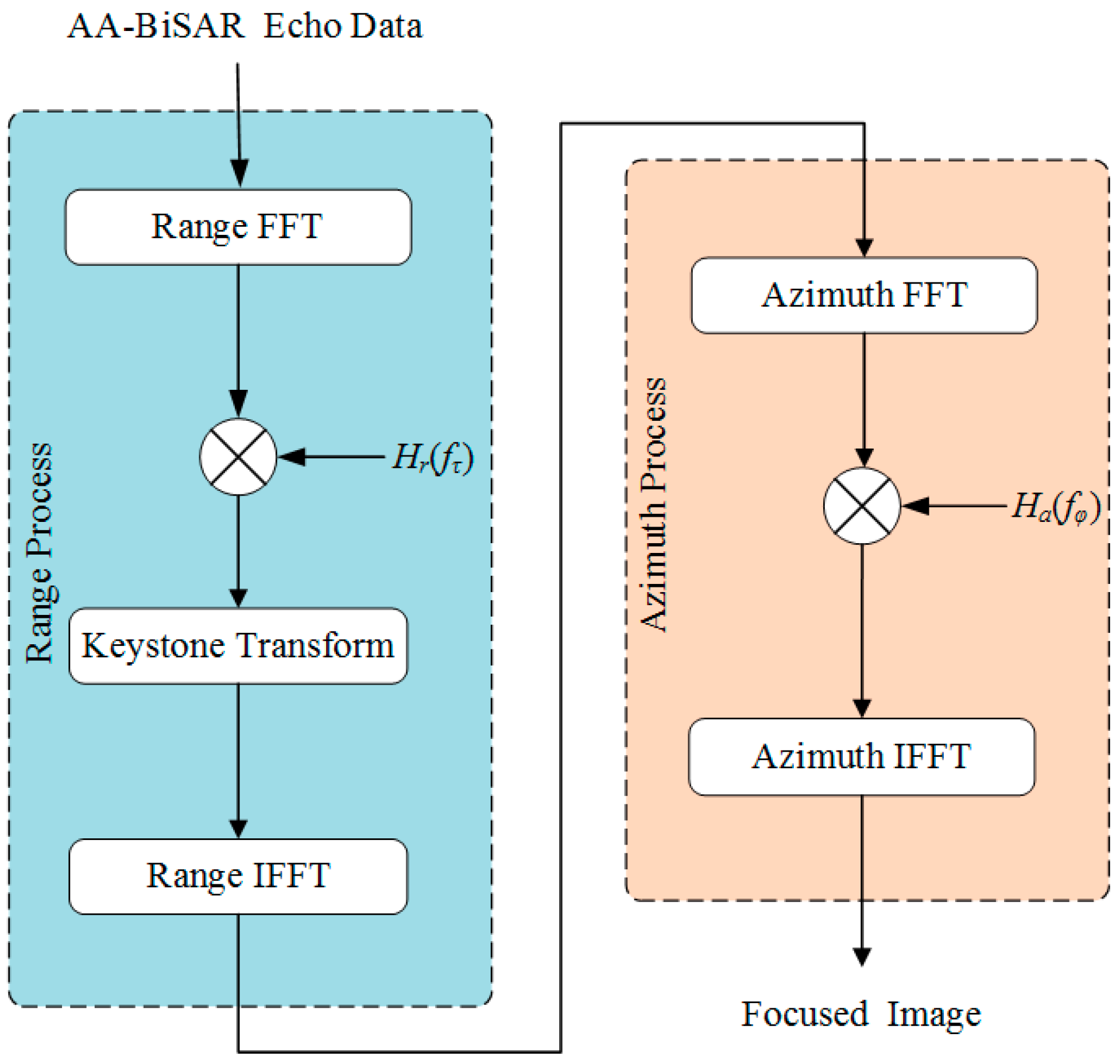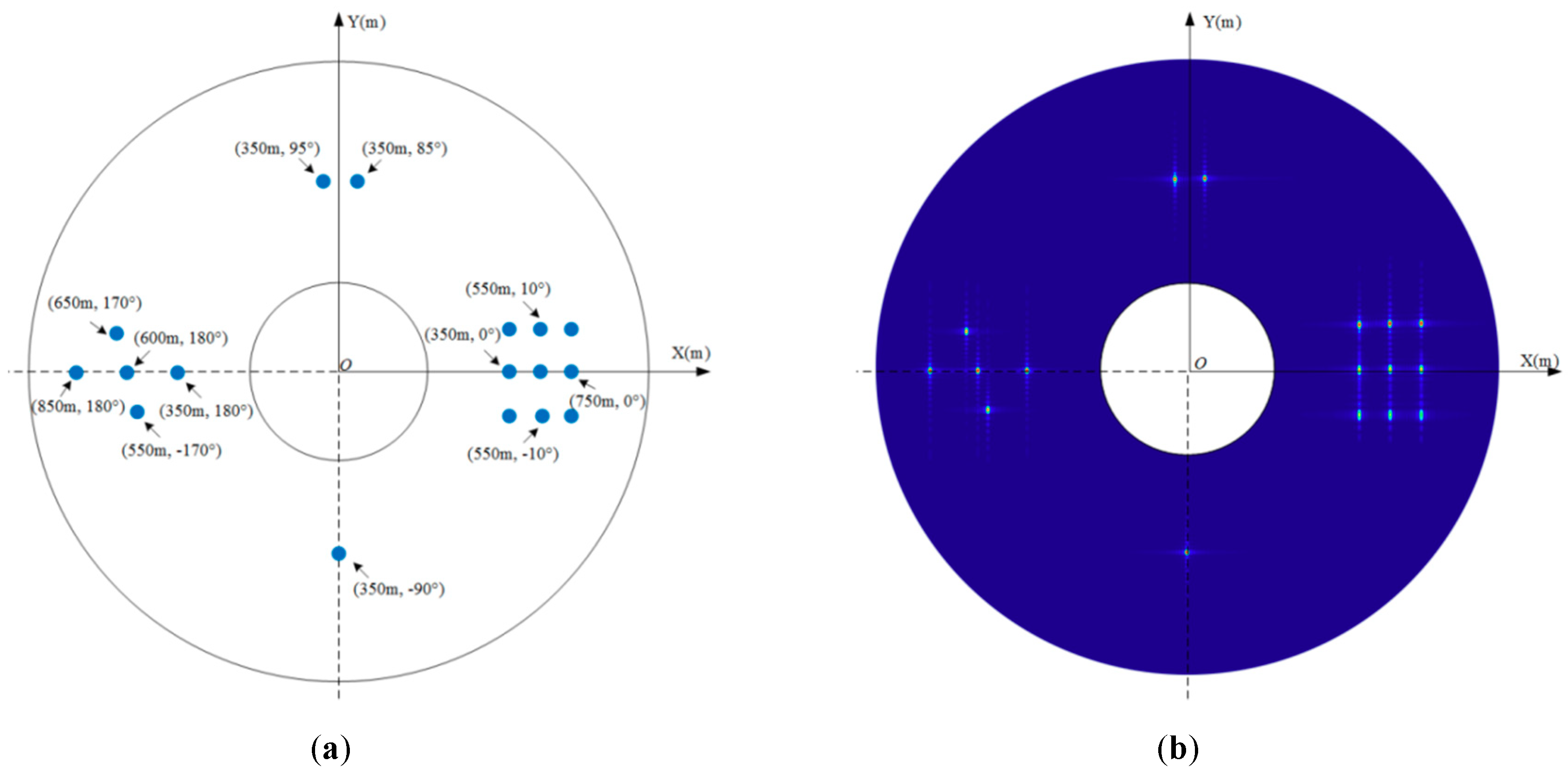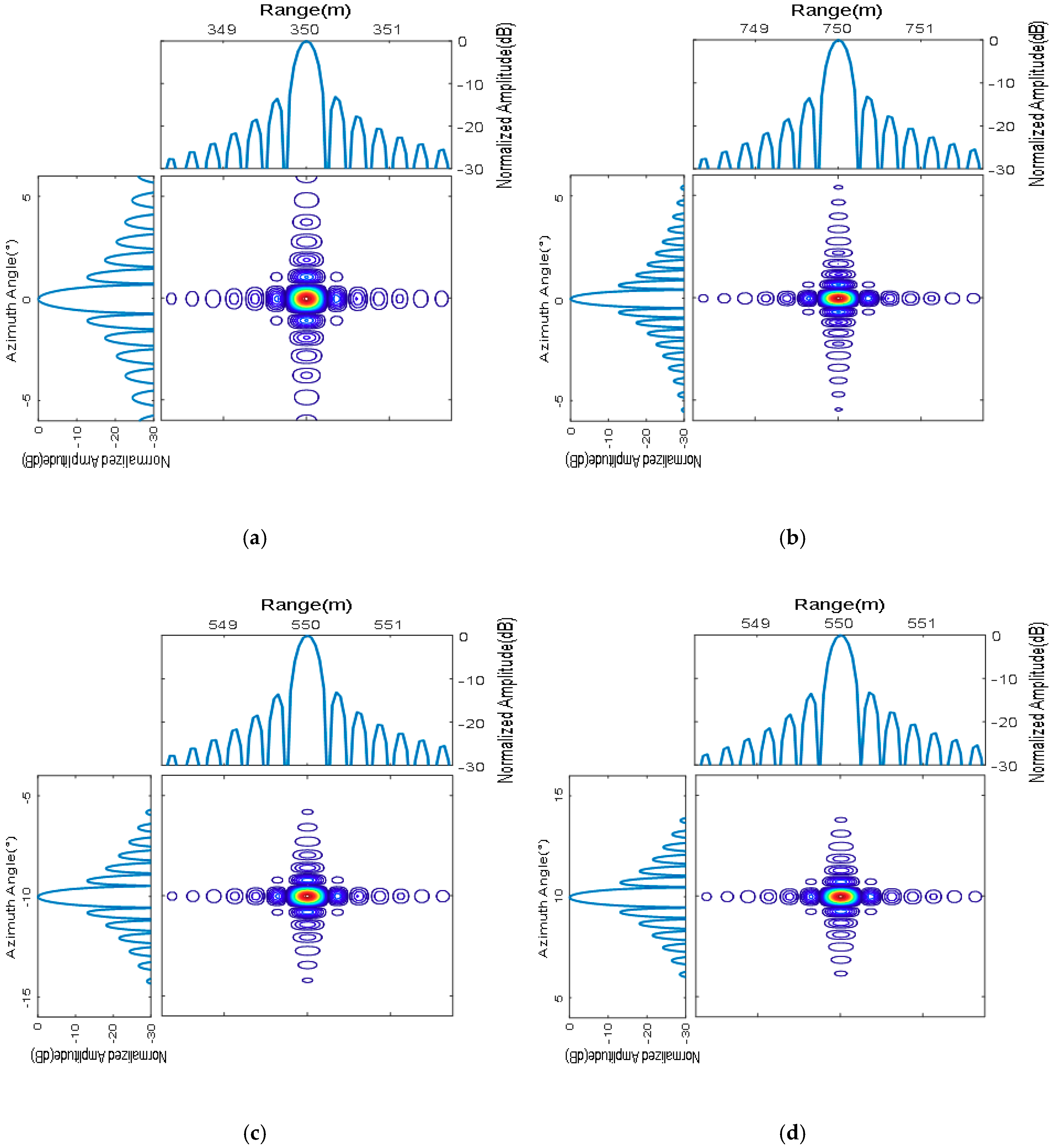Focusing Arc-Array Bistatic Synthetic Aperture Radar Data Based on Keystone Transform
Abstract
1. Introduction
2. Arc-Array Bistatic Synthetic Aperture Radar (SAR) System
- ➢
- For the position of equivalent sampling point , stands for the radius of the arc-array antenna, denotes the azimuth direction angle of , stands for the height of the arc-array antenna.
- ➢
- For the position of point target , is referred to the distance from to the origin of coordinate , represents the azimuth direction angle of , stands for the height of .
- ➢
- For the position of transmitter , represents the angle of in polar coordinates. is referred to the ground distance from to , is the height of
3. Imaging Algorithm Based on Keystone Transform
3.1. Signal Model
3.2. Range Process and Keystone Transform
3.3. Azimuth Process
4. Resolution Analysis
4.1. Azimuth Angular Resolution
4.2. Ground-Range Resolution
5. Numerical Simulation Experiments
6. Conclusions
Author Contributions
Funding
Conflicts of Interest
References
- Cumming, I.G.; Wong, F.H. Digital Signal Processing of Synthetic Aperture Radar Data; Artech House: Norwood, MA, USA, 2005. [Google Scholar]
- An, D.; Huang, X.; Tian, J.; Zhou, Z. Extended nonlinear chirp scaling algorithm for high-resolution Highly squint SAR data focusing. IEEE Trans. Geosci. Remote Sens. 2012, 50, 3595–3609. [Google Scholar] [CrossRef]
- Lombardini, F.; Viviani, F. 4D characterization of short- and long-term height-varying decorrelated forest SAR backscattering. In Proceedings of the 2015 IEEE International Geoscience and Remote Sensing Symposium (IGARSS), Milan, Italy, 26–31 July 2015; pp. 1547–1550. [Google Scholar]
- Lombardini, F.; Viviani, F. Multidimensional SAR tomography: Advances for urban and prospects for forest/ice applications. In Proceedings of the 2014 11th European Radar Conference, Rome, Italy, 8–10 October 2014; pp. 225–228. [Google Scholar]
- Pieraccini, M.; Miccinesi, L. An Interferometric MIMO Radar for bridge monitoring. IEEE Geosci. Remote Sens. Lett. 2019, 16, 1–5. [Google Scholar] [CrossRef]
- Pieraccini, M.; Miccinesi, L. Bistatic ArcSAR. In Proceedings of the 2018 2nd URSI Atlantic Radio Science Meeting (AT-RASC), Gran Canaria, Spain, 28 May–1 June 2018; pp. 1–4. [Google Scholar]
- Arii, M.; Yamada, H.; Kojima, S.; Ohki, M. Review of the Comprehensive SAR Approach to Identify Scattering Mechanisms of Radar Backscatter from Vegetated Terrain. Electronics 2019, 8, 1098. [Google Scholar] [CrossRef]
- Huang, P.P.; Deng, Y.K.; Xu, W. Research on multiple-input and multiple-output SAR imaging based on CS algorithm. J. Univ. Electron. Sci. Technol. China 2012, 41, 222–226. [Google Scholar]
- Huang, P.P.; Li, H.C.; Feng, F.; Huang, M. The waveform analysis and signal processing for space-borne MIMO-SAR. In Proceedings of the European Conference on Synthetic Aperture Radar, Nuremberg, Germany, 23–26 April 2012. [Google Scholar]
- Hu, R.; Peng, Z.; Ma, J. A vehicle target recognition algorithm for wide-angle SAR based on joint feature set matching. Electronics 2019, 8, 1252. [Google Scholar] [CrossRef]
- Wang, X.; Qiao, L. Refocusing of Multiple Moving Targets Based on the Joint Sparse Processing of One Channel Synthetic Aperture Radar Imagery Patches. Electronics 2019, 8, 1215. [Google Scholar] [CrossRef]
- Huang, P.; Tan, W.; Su, Y. MIMO-SAR imaging technology for helicopter-borne based on ARC antenna array. In Proceedings of the Geoscience & Remote Sensing Symposium, Milan, Italy, 26–31 July 2015. [Google Scholar]
- Huang, P.P. Research on imaging algorithm with MIMO-SAR based on arc antenna array. In Proceedings of the High Resolution Earth Observation Confernence, Beijing, China, 1 December 2014. [Google Scholar]
- Huang, P.P.; Tan, W.X.; Ying, S.; Chi, W. Research on helicopter-borne MIMO microwave imaging technology based on arc antenna array. J. Radars 2015, 4, 11–19. [Google Scholar]
- Michelini, A.; Viviani, F.; Mayer, L. Introduction to IBIS-ArcSAR a circular scanning GB-SAR system for deformation monitoring. In Proceedings of the 4th Joint International Symposium on Deformation Monitoring (JISDM), Athens, Greece, 15–17 May 2019. [Google Scholar]
- Viviani, F.; Michelini, A.; Mayer, L.; Coppi, F. IBIS-ArcSAR: An innovative ground-based SAR system for slope monitoring. In Proceedings of the IGARSS 2018—2018 IEEE International Geoscience and Remote Sensing Symposium, Valencia, Spain, 22–27 July 2018. [Google Scholar]
- Huang, Z.; Sun, J.; Tan, W.; Huang, P.; Han, K. Investigation of wavenumber domain imaging algorithm for ground-based arc array SAR. Sensors 2017, 17, 2950. [Google Scholar] [CrossRef]
- Pieraccini, M.; Miccinesi, L. ArcSAR: theory, simulations, and experimental verification. IEEE Trans. Microw. Theory Tech. 2017, 65, 1–9. [Google Scholar] [CrossRef]
- Miccinesi, L.; Pieraccini, M. ArcSAR for detecting target elevation. Electron. Lett. 2016, 52, 1559–1561. [Google Scholar]
- Luo, Y.; Song, H.; Wang, R.; Deng, Y.; Zhao, F.; Zheng, X. Arc FMCW SAR and applications in ground monitoring. IEEE Trans. Geosci. Remote Sens. 2014, 52, 5989–5998. [Google Scholar] [CrossRef]
- Lee, H.; Lee, J.H.; Kim, K.E.; Sung, N.H.; Cho, S.J. Development of a truck-mounted arc-Scanning synthetic aperture radar. IEEE Trans. Geosci. Remote Sens. 2014, 52, 2773–2779. [Google Scholar] [CrossRef]
- Chen, P.; Cao, Z.; Chen, Z.; Yu, C. Sparse DOD/DOA estimation in a bistatic MIMO radar with mutual coupling effect. Electronics 2018, 7, 341. [Google Scholar] [CrossRef]
- An, H.; Wu, J.; Sun, Z.; Yang, J. A two-step nonlinear chirp scaling method for multichannel GEO spaceborne-airborne bistatic SAR spectrum reconstructing and focusing. IEEE Trans. Geosci. Remote Sens. 2019, 57, 3713–3728. [Google Scholar] [CrossRef]
- Comblet, F.; Khenchaf, A.; Baussard, A.; Pellen, F. Bistatic Synthetic Aperture Radar Imaging: Theory, Simulations, and Validations. IEEE Trans. Antennas Propag. 2006, 54, 3529–3540. [Google Scholar] [CrossRef]
- Wu, J.; Sun, Z.; An, H.; Qu, J.; Yang, J. Azimuth signal multichannel reconstruction and channel configuration design for geosynchronous spaceborne-airborne bistatic SAR. IEEE Trans. Geosci. Remote Sens. 2019, 57, 1861–1872. [Google Scholar] [CrossRef]
- Zhang, Q.; Wu, J.; Li, Z.; Miao, Y.; Huang, Y.; Yang, J. PFA for bistatic forward-looking SAR mounted on high-speed maneuvering platforms. IEEE Trans. Geosci. Remote Sens. 2019, 57, 6018–6036. [Google Scholar] [CrossRef]
- Walterscheid, I.; Ender, J.H.G.; Brenner, A.R.; Loffeld, O. Bistatic SAR processing and experiments. IEEE Trans. Geosci. Remote Sens. 2006, 44, 2710–2717. [Google Scholar] [CrossRef]
- Yates, G.; Home, A.M.; Blake, A.P.; Middleton, R. Bistatic SAR image formation. IEE Proc. Radar Sonar Navig. 2006, 153, 208–213. [Google Scholar] [CrossRef]
- Wang, R.; Loffeld, O.; Neo, Y.L.; Nies, H.; Walterscheid, I.; Espeter, T.; Klare, J.; Ender, J. Focusing Bistatic SAR Data in Airborne/Stationary Configuration. IEEE Trans. Geosci. Remote Sens. 2009, 48, 452–465. [Google Scholar] [CrossRef]
- Xie, H.; Shi, S.; An, D.; Wang, G.; Wang, G.; Hui, X.; Huang, X.; Zhou, Z.; Chao, X.; Feng, W. Fast factorized backprojection algorithm for one-stationary bistatic spotlight circular SAR Image formation. IEEE J. Sel. Top. Appl. Earth Obs. Remote Sens. 2017, 10, 1494–1510. [Google Scholar] [CrossRef]
- Li, Z.; Wu, J.; Huang, Y.; Sun, Z.; Yang, J. One-stationary bistatic forward-looking SAR for moving target detection and imaging with a linear antenna array. In Proceedings of the Geoscience & Remote Sensing Symposium, Quebec City, QC, Canada, 13–18 July 2014. [Google Scholar]
- Xie, H.; An, D.; Huang, X.; Zhou, Z. Research on spatial resolution of one-stationary bistatic ultrahigh frequency ultrawidebeam–ultrawideband SAR based on scattering target wavenumber domain support. IEEE J. Sel. Top. Appl. Earth Obs. Remote Sens. 2015, 8, 1782–1798. [Google Scholar] [CrossRef]
- Wu, J.; Li, Z.; Huang, Y.; Yang, J.; Liu, Q.H. Omega-K imaging algorithm for one-stationary bistatic SAR. IEEE Trans. Aerosp. Electron. Syst. 2014, 50, 33–52. [Google Scholar] [CrossRef]
- Dai, C.; Zhang, X.; Shi, J. Range cell migration correction for bistatic SAR image formation. IEEE Geosci. Remote Sens. Lett. 2011, 9, 124–128. [Google Scholar] [CrossRef]
- Perry, R.P.; Dipietro, R.C.; Fante, R.L. SAR imaging of moving targets. IEEE Trans. Aerosp. Electron. Syst. 1999, 35, 188–200. [Google Scholar] [CrossRef]
- Kai, H.; Liu, Y.; Hu, J.; Jiang, W.; Xiang, L. A novel imaging method for fast rotating targets based on the segmental pseudo keystone transform. IEEE Trans. Geosci. Remote Sens. 2011, 49, 1464–1472. [Google Scholar]
- Li, G.; Xia, X.G.; Peng, Y.N. Doppler Keystone Transform: An Approach Suitable for Parallel Implementation of SAR Moving Target Imaging. IEEE Geosci. Remote Sens. Lett. 2008, 5, 573–577. [Google Scholar] [CrossRef]
- Li, W.; Yang, J.; Huang, Y. Keystone transform-based space-variant range migration correction for airborne forward-looking scanning radar. Electron. Lett. 2012, 48, 121–122. [Google Scholar] [CrossRef]
- Zhu, D.; Yong, L.; Zhu, Z. A Keystone Transform Without Interpolation for SAR Ground Moving-Target Imaging. IEEE Geosci. Remote Sens. Lett. 2007, 4, 18–22. [Google Scholar] [CrossRef]
- Rodriguez-Cassola, M.; Baumgartner, S.V.; Krieger, G.; Moreira, A. Bistatic TerraSAR-X/F-SAR spaceborne-airborne SAR experiment: Description, data processing, and results. IEEE Trans. Geosci. Remote Sens. 2010, 48, 781–794. [Google Scholar] [CrossRef]
- Krieger, G.; Fiedler, H.; Hounam, D.; Moreira, A. Analysis of System Concepts for Bi-and Multistatic SAR Missions. In Proceedings of the IEEE International Geoscience & Remote Sensing Symposium, Toulouse, France, 21–25 July 2003. [Google Scholar]
- Cardillo, G.P. On the use of the gradient to determine bistatic SAR resolution. In Proceedings of the Antennas & Propagation Society International Symposium, Dallas, TX, USA, 7–11 May 1990. [Google Scholar]
- Qiu, X.; Ding, C.; Hu, D. Bistatic SAR Data Processing Algorithms; John Wiley & Sons: New York, NY, USA, 2012. [Google Scholar]






| Symbol | Definition | Value |
|---|---|---|
| Carrier Frequency | 40.5 GHz | |
| Signal Bandwidth | 650 MHz | |
| Sweep Time | 0.15 ms | |
| Arc-Array Radius | 0.6 m | |
| Array Beam width (−3 dB) | 56° | |
| Height of Receiving Platform | 650 m | |
| Position of Transmitting Platform | (200 m, 3000 m, 600 m) |
| Target | Range | Azimuth | ||||||
|---|---|---|---|---|---|---|---|---|
| Ground-Range Resolutions (m) | PSLR (dB) | ISLR (dB) | Azimuth Angular Resolutions (°) | PSLR (dB) | ISLR (dB) | |||
| Theoretical Values | Actual Results | Theoretical Values | Actual Results | |||||
| P1 | 0.478 | 0.481 | −13.206 | −9.498 | 0.951 | 0.955 | −12.702 | −8.879 |
| P2 | 0.493 | 0.495 | −13.213 | −9.499 | 0.633 | 0.634 | −12.683 | −8.851 |
| P3 | 0.462 | 0.464 | −13.402 | −9.536 | 0.722 | 0.726 | −12.697 | −8.985 |
| P4 | 0.551 | 0.557 | −13.193 | −9.212 | 0.722 | 0.729 | −12.636 | −8.803 |
© 2019 by the authors. Licensee MDPI, Basel, Switzerland. This article is an open access article distributed under the terms and conditions of the Creative Commons Attribution (CC BY) license (http://creativecommons.org/licenses/by/4.0/).
Share and Cite
Huang, P.; Li, K.; Xu, W.; Tan, W.; Gao, Z.; Li, Y. Focusing Arc-Array Bistatic Synthetic Aperture Radar Data Based on Keystone Transform. Electronics 2019, 8, 1389. https://doi.org/10.3390/electronics8121389
Huang P, Li K, Xu W, Tan W, Gao Z, Li Y. Focusing Arc-Array Bistatic Synthetic Aperture Radar Data Based on Keystone Transform. Electronics. 2019; 8(12):1389. https://doi.org/10.3390/electronics8121389
Chicago/Turabian StyleHuang, Pingping, Kai Li, Wei Xu, Weixian Tan, Zhiqi Gao, and Yachao Li. 2019. "Focusing Arc-Array Bistatic Synthetic Aperture Radar Data Based on Keystone Transform" Electronics 8, no. 12: 1389. https://doi.org/10.3390/electronics8121389
APA StyleHuang, P., Li, K., Xu, W., Tan, W., Gao, Z., & Li, Y. (2019). Focusing Arc-Array Bistatic Synthetic Aperture Radar Data Based on Keystone Transform. Electronics, 8(12), 1389. https://doi.org/10.3390/electronics8121389






